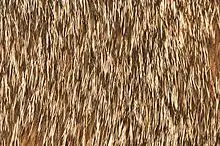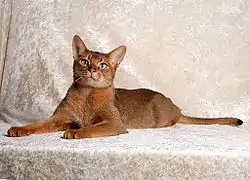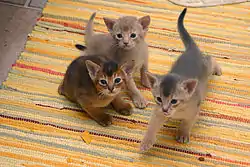| Abyssinian | |
|---|---|
 A male ruddy Abyssinian | |
| Common nicknames | Abys |
| Origin | Indian Ocean, Southeast Asia[1] |
| Breed standards | |
| CFA | standard |
| FIFe | standard |
| TICA | standard |
| ACF | standard |
| CCA-AFC | standard |
| GCCF | standard |
| Domestic cat (Felis catus) | |
The Abyssinian /æbɪˈsɪniən/ is a breed of domestic short-haired cat with a distinctive "ticked" tabby coat, in which individual hairs are banded with different colors.[2] They are also known simply as Abys.[3]
The first members of the breed to be exhibited in England were brought there from Abyssinia (now known as Ethiopia), whence the name. Genetic studies place the breed's origins in Southeast Asia and the coasts of the Indian Ocean, however. It is possible that the breed was introduced to Abyssinia by travelers who had stopped in Calcutta.[4]
Once a comparatively obscure breed, the Abyssinian had become one of the top five most popular cat breeds by 2016.[3]
The breed's distinctive appearance, seeming long, lean and finely colored compared to other cats, has been analogized to that of human fashion models. Personality-wise, the cats traditionally display active, curious attitudes in which they frequently follow owners around and encourage play.[3] Their dog-like characteristics also involve a particular sense of affection and desire for interaction. Abys have a distinctive wildcat look with their ticked coat and large erect ears. They are a highly social breed and can be demanding of attention. They do well in multi-cat households due to their social nature. Not a lap cat, Abyssinians are in constant motion, either exploring or playing.[5]
History

What is thought to be the earliest known designated Abyssinian cat is in an exhibit still residing in the Leiden Zoological Museum in Holland. It was purchased around 1834-1836 from a supplier of small wild cat exhibits as a taxidermy and was labeled by the museum founder as "Patrie, domestica India."[6] The first example of a domesticated Abyssinian, however, involves the story of a cat being brought to England by the British Lt. General Sir Robert Napier in 1868 who had returned from the Abyssinia War. The cat was given the name "Zula" and won first prize in the December 1871 Crystal Palace cat show.[6][7]
Many modern Abyssinian breeders dispute Zula as having been the first domestic Abyssinian, arguing that the existing illustrations of Zula portray the cat as having ears too small for an Abyssinian and a coat too waved and long.
The breed was nearly wiped out in the United Kingdom following the Second World War and an outbreak of feline leukaemia virus, resulting in cats being imported from places such as Holland, America, Scandinavia, Australia, and New Zealand.[8]
The Abyssinian is one of the oldest established cat breeds, being recognised in 1929 by the Governing Council of the Cat Fancy. The breed was developed in the United Kingdom with references dating back to the 1890′s.[8][9]
Description
Appearance
The Abyssinian is a lithe, fine-boned, muscular, medium to large sized cat. The average weight is 10 lb (4.5 kg) ranging between 8–12 lb (3.6–5.4 kg) with height ranging between 8–10 in (20–25 cm).[9][10] The head is moderately wedge-shaped, with a slight break at the muzzle, and nose and chin ideally forming a straight vertical line when viewed in profile. They have alert, relatively large pointed ears. The eyes are almond-shaped and are gold, green, hazel or copper depending on coat color. The legs tend to be long in proportion to a graceful body, with small oval paws; the tail is likewise long and tapering.[11]

Abyssinian kittens are born with dark coats that gradually lighten as they mature, usually over several months. The coat is short, and is ideally fine, not soft, dense, close-lying and silky to the touch. The ticked or agouti effect that is the trademark of the breed—genetically a variant of the tabby pattern—should be uniform over the body, although the ridge of the spine and tail, back of the hind legs and the pads of the paws are always noticeably darker. Each hair has a light base with three or four bands of additional color growing darker towards the tip. The base color should be as clear as possible; any extensive intermingling with grey is considered a serious fault. A tendency to white on the chin is common but likewise must be minimal. The typical tabby M-shaped marking is often found on the forehead.[9][11]

The breed's original color standard is a warm deep reddish-brown base with black ticking, known as "usual" in the United Kingdom, "tawny" in Australia, and "ruddy" elsewhere. Sorrel (also called cinnamon or red), a lighter coppery base with chocolate brown ticking, is a unique mutation of this original pattern. Other variants have been introduced by outcrossing to the Burmese and other shorthaired breeds, notably blue (on a warm beige base) and fawn (on a softer creamy peach base). The less common chocolate and lilac are not recognized in the Cat Fancier's Association (CFA) breed standard[12] but have been granted full champion status in The International Cat Association (TICA)[13] and in the UK. The UK also recognizes the Silver Abyssinian, in which the base coat is a pure silvery white with black (called "usual silver"), blue, cream or sorrel ticking. Various other color combinations are in development, including the "torbie", in which a patched tortoiseshell pattern in any of these colors is visible under the tabby banding.
The breed owes their distinctive coat to a dominant mutant gene known as Ta. In 2007, the first cat to have its entire genome published was an Abyssinian named Cinnamon.[14]
Behaviour

Veterinarian Joan O. Joshua has written that the "dog-like attachment to the owners" of Abyssinian and Burmese cats causes "greater dependence on human contacts". This stands in contrast to the mere "tolerant acceptance of human company" based around "comforts" that multiple other breeds display.[5]
With their interest in playing with their owners combined with their curious intelligence, Abyssinians are sometimes called the "Clowns of the Cat Kingdom".[3] They have soft chirrup-like vocalizations which do not sound like the expected "meow".
A study comparing Oriental, Siamese and Abyssinian kittens to Norwegian Forest cat kittens found that the former group was more likely to recede and hide as well as display other 'shy' behaviour.[15]
Health
The breed can be prone to gingivitis, which can lead to more serious periodontitis.[16] Familial renal amyloidosis or AA amyloidosis, a kidney disorder due to a mutation in the AA amyloid protein gene, has been seen in Abyssinians.[17] The Abyssinian has had severe problems with blindness caused by a hereditary retinal degeneration due to mutations in the rdAc gene. However, the prevalence has been reduced from 45% to less than 4% in 2008 in the country of Sweden.[18] With the widespread availability of rdAc mutation detection tests and services, such as those provided by the UC Davis Veterinary Genetics Laboratory, it is possible to reduce the disease frequency in all populations of Abyssinian.[19][20] An Australian analysis found the Abyssinian to be over-represented in cases of feline infectious peritonitis when compared to the expected frequency based on census data (4.4% versus 1.5%).[21] In a review of over 5,000 cases of urate urolithiasis the Abyssinian was significantly under-represented, with only one of the recorded cases belonging to an Abyssinian.[22]
The 2008 study "The Ascent of Cat Breeds: Genetic Evaluations of Breeds and Worldwide Random-bred Populations" by Lipinski et al. conducted at UC Davis by the team led by leading feline geneticist Dr Leslie Lyons found that the Abyssinian has a low level of genetic diversity, a heterozygosity value of 0.45 within a range of 0.34–0.69 for all breeds studied, and has genetic markers common to both Southeast Asian and Western breeds indicating that cats from both Asia and Europe were used to create the breed.[23]
See also
References
- ↑ "About the Abyssinian". www.cfainc.org. Archived from the original on 22 April 2023. Retrieved 26 June 2023.
- ↑ "Abyssinian Breed Description". catzinc.org. Retrieved 31 January 2018.
- 1 2 3 4 "Abyssinian". VCA Animal Hospitals. Retrieved 9 September 2016.
- ↑ "About the Abyssinian". Archived from the original on 5 January 2013. Retrieved 31 January 2018.
- 1 2 Joshua, Joan O. (2013). The Clinical Aspects of Some Diseases of Cats. Elsevier. p. 1. ISBN 9781483226002.
- 1 2 "Abyssinian". 23 July 2013.
- ↑ "All About Abyssinian Cats - History of the Abyssinian Cat".
- 1 2 Barnes-Hookey, Jacquie. "History of the Abyssinian Cat". Abyssinian Cat Association. Retrieved 1 January 2024.
- 1 2 3 "Abyssinian". Governing Council of the Cat Fancy. Retrieved 1 January 2024.
- ↑ Leeson, Janelle. "Abyssinian". PetMD. Retrieved 3 January 2024.
- 1 2 "Abysinnian standard". Abyssinian Cat Club. Retrieved 3 January 2024.
- ↑ "Abyssinian : POINT SCORE" (PDF). Cfainc.org. Retrieved 15 December 2017.
- ↑ "Abyssinian Breed Group Standard" (PDF). Tica.org. 1 May 2008. Archived from the original (PDF) on 17 April 2015. Retrieved 15 December 2017.
- ↑ Highfield, Roger (31 October 2007). "Cinnamon the cat could offer hope to the blind". The Daily Telegraph. Archived from the original on 3 November 2007. Retrieved 26 June 2023.
- ↑ Marchei, P.; Diverio, S.; Falloci, N.; Fatjó, J.; Ruiz-de-la-Torre, J. L.; Manteca, X. (23 March 2009). "Breed differences in behavioural development in kittens". Physiology & Behavior. 96 (4–5): 522–531. doi:10.1016/j.physbeh.2008.11.015. S2CID 12358514. Retrieved 6 January 2024.
- ↑ "Periodontitis - Cat". Vetbook.org. 19 October 2012. Retrieved 27 December 2013.
- ↑ Niewold TA, van der Linde-Sipman JS, Murphy C, Tooten PC, Gruys E (September 1999). "Familial amyloidosis in cats: Siamese and Abyssinian AA proteins differ in primary sequence and pattern of deposition". Amyloid. 6 (3): 205–9. doi:10.3109/13506129909007328. PMID 10524286.
- ↑ "Theodosius Dobzhansky Center for Genome Bioinformatics" (PDF). Dobzhanskycenter.bio.spbu.ru. Archived from the original (PDF) on 17 December 2013. Retrieved 15 December 2017.
- ↑ "Cat Progressive Retinal Atrophy". Vgl.ucdavis.edu. Retrieved 27 December 2013.
- ↑ Lyons LA (December 2012). "Genetic testing in domestic cats". Molecular and Cellular Probes. 26 (6): 224–30. doi:10.1016/j.mcp.2012.04.004. PMC 3541004. PMID 22546621.
- ↑ Worthing, Kate A; Wigney, Denise I; Dhand, Navneet K; Fawcett, Anne; McDonagh, Phillip; Malik, Richard; Norris, Jacqueline M (7 March 2012). "Risk factors for feline infectious peritonitis in Australian cats". Journal of Feline Medicine and Surgery. 14 (6): 405–412. doi:10.1177/1098612X12441875. PMID 22398460. Retrieved 7 January 2024.
- ↑ Albasan, H.; Osborne, C. A.; Lulich, J. P.; Lekcharoensuk, C. (2012). "Risk factors for urate uroliths in cats". Journal of the American Veterinary Medical Association. 240 (7): 842–847. doi:10.2460/javma.240.7.842. PMID 22443437.
- ↑ Lipinski MJ, Froenicke L, Baysac KC, Billings NC, Leutenegger CM, Levy AM, Longeri M, Niini T, Ozpinar H, Slater MR, Pedersen NC, Lyons LA (January 2008). "The ascent of cat breeds: genetic evaluations of breeds and worldwide random-bred populations". Genomics. 91 (1): 12–21. doi:10.1016/j.ygeno.2007.10.009. PMC 2267438. PMID 18060738.
- Lipinski MJ, Froenicke L, Baysac KC, Billings NC, Leutenegger CM, Levy AM, Longeri M, Niini T, Ozpinar H, Slater MR, Pedersen NC, Lyons LA (January 2008). "The ascent of cat breeds: genetic evaluations of breeds and worldwide random-bred populations". Genomics. 91 (1): 12–21. doi:10.1016/j.ygeno.2007.10.009. PMC 2267438. PMID 18060738.